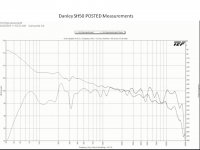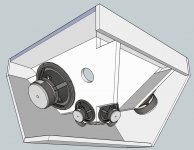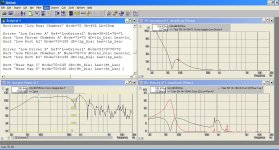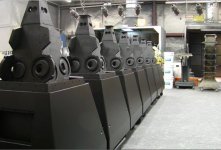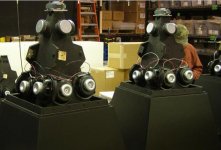I can't get over how well that faux-axial horn sounds.
I've listened to it all weekend.
The good:
The speaker has incredible resolution. It's particularly noticeable on vocals - you can hear things buried in the mix like never before. Very articulate. All the things you like about a Unity.
The bad:
There's some kind of a suckout. I haven't measured it, but there are some frequencies that just aren't there. Power handling isn't very good. It's not very efficient.
I'm not ready to go back to the drawing board just yet; I think this could be promising if it used a driver with higher efficiency and better power handling. (hint hint NEO8)
It looks to me like you're going in a direction that's basically going to end in a planar variant of the Quad ESL-63.
Member
Joined 2009
I've listened to it all weekend.
The good:
The speaker has incredible resolution. It's particularly noticeable on vocals - you can hear things buried in the mix like never before. Very articulate. All the things you like about a Unity.
The bad:
There's some kind of a suckout. I haven't measured it, but there are some frequencies that just aren't there. Power handling isn't very good. It's not very efficient.
I'm not ready to go back to the drawing board just yet; I think this could be promising if it used a driver with higher efficiency and better power handling. (hint hint NEO8)
I'm guessing that high frequencies from the cone are interfering with the ones from the dust cap. There should be some mechanism to attenuate high frequencies from the cone, maybe some absorbing felt, or a clever tunning of the side ports to act as low pass filters. Sound coming out of the side ports should be low passed at 1/4wavelength of the port distance. Measurements will be able to tell a lot.
For comparison's sake, here's one of my car audio Unity horns. (Not a good one - or finished.)
johnny cash on unity horn (in a corner).mp4 - YouTube
Here's a JBL array, playing the same song, to give this some context.
3 driver full range-2.mp4 - YouTube
I received an email asking about how to build the underdash Unity horn that's in the video above.
Later this week I'll take a few minutes to post proper dimensions.
Here's some info to get you started:
- The woofers are a pair from Misco, but the Pyle PDMR5 is virtually a drop in replacement. ($18.78 here Pyle Pro PDMR5 5" Sealed Back Midrange 292-200)
- The compression driver is my trusty CDX1-1425 ($94.99 here Celestion CDX1-1425 Neo 1" Compression Driver 25W 294-2132 )
- I have some pictures of this horn on my audiopsychosis forum; there are enough pics there to figure out the dimensions fairly easily, but I'll post exact measurements here shortly.
The crossover is totally basic; it's literally two resistors and a capacitor. The midrange drivers aren't crossed at all. A few hours with a microphone and a copy of Arta would work wonders for this thing.
One nice thing I've noticed about the Unity horns is that they're fairly forgiving of crappy crossovers. For instance, if you're trying to do a crossover from a midrange in your car door to a tweeter in the A-Pillar, the xover can be a real nightmare. This is due to the huge distance between the two drivers, the fact that they have different polar response, and you're listening to them off-axis. A Unity horn, oddly enough, is a bit forgiving because the drivers are so darn close together.
This isn't to say that a good crossover isn't important - it's VERY important - just to say that kludgey Unity horns sound surprisingly good.
In the video, you can clearly hear the most challenging part of the design, which is that miserable suckout between the compression driver and the woofers. Which is how this whole thread started, five years ago!
I have a wholesale account at PE and no one takes my up on saving a couple of dollars using it.
I got my proof of concept micro unity playing with a pair of Misco 3s and a B&C DE5 on it...wow. That DE5 is such a nice driver. Miscos are no slouch either. Low level detail is amazing. I can find the limits of the Miscos fairly easy but I don't remember how low they are crossed. And I need to figure out how to get 2 more on each horn. I haven' reEQed anything yet but there is a lot of potential there.
Looking like the XO point is right around 5k between the Miscos and DE5s.
I got my proof of concept micro unity playing with a pair of Misco 3s and a B&C DE5 on it...wow. That DE5 is such a nice driver. Miscos are no slouch either. Low level detail is amazing. I can find the limits of the Miscos fairly easy but I don't remember how low they are crossed. And I need to figure out how to get 2 more on each horn. I haven' reEQed anything yet but there is a lot of potential there.
Looking like the XO point is right around 5k between the Miscos and DE5s.
That is really a bit high of a crossover frequency. When working with wavelengths that short, it is almost impossible to get phase alignment between the comp driver and mids correct. I know looking at the impedance sweep of the DE5 on the B&C website makes you want to cross it at 5KHz, but it just makes everything so much more difficult for your crossover and mid placement. You can still contour the impedance of the DE5 within the crossover, so I'd try to cross lower. If possible try to get it down to at least 2KHZ or 2.5KHz.
There are several things that can be done to increase the power handling of the RDC3T-A on a Unity. I have one Akabak model where the excursion of the RDC3T-A is only 0.2mm with an input of 24Vrms.
There are several things that can be done to increase the power handling of the RDC3T-A on a Unity. I have one Akabak model where the excursion of the RDC3T-A is only 0.2mm with an input of 24Vrms.
Thanks John! Been meaning to email, haven't forgotten...dad had a knee replacement last week and I spent all weekend getting their yard mowed and stuff taken care of for him.
I am thinking of making the ports larger too...right now they are 3/8ths of an inch x4 since two mids.
And I just happened to have the parts laying around in my old parts stash to make that XO to get a flavor for the project. I like it enough to keep on going
Well I just went and made some changes per John...much better. Few other changes to do still...not enough of the size resistor that I need. Much much better...lot of the gack is gone. Might be too much velocity in the ports past 4k?
I am thinking of making the ports larger too...right now they are 3/8ths of an inch x4 since two mids.
And I just happened to have the parts laying around in my old parts stash to make that XO to get a flavor for the project. I like it enough to keep on going
Well I just went and made some changes per John...much better. Few other changes to do still...not enough of the size resistor that I need. Much much better...lot of the gack is gone. Might be too much velocity in the ports past 4k?
Port velocity lessens at high frequency, but cone breakup (gack) increases.Well I just went and made some changes per John...much better. Few other changes to do still...not enough of the size resistor that I need. Much much better...lot of the gack is gone. Might be too much velocity in the ports past 4k?
Danley's SH50 Synergy horn measures H=28", W=28", D=22.5". Big'ish.
Danley's SH50 Synergy horn specs +/- 3db of 50Hz and 18KHz, but the posted measured data does not totally support this.
Has anyone modeled or experimented with a H=36", W=36" D=?? 3-way 60x60 or 50x50 Synergy Horn that is optimized for 3-way performance? Perhaps with 4-woofers? What +/- 3db performance do you think is possible?
36" wavelength = 380 Hz
Danley's SH50 Synergy horn specs +/- 3db of 50Hz and 18KHz, but the posted measured data does not totally support this.
Has anyone modeled or experimented with a H=36", W=36" D=?? 3-way 60x60 or 50x50 Synergy Horn that is optimized for 3-way performance? Perhaps with 4-woofers? What +/- 3db performance do you think is possible?
36" wavelength = 380 Hz
Attachments
Hi LineSource,
I have modelled a 3-way 60x60 horn 27"x27" horn. I was only able to squeeze in 2x 10" drivers but really struggled to find a driver that would produce bass much below ~80-100Hz using a cabinet that must be quite similar to the SH50.
The real problem is that you start to run into air-velocity issues at high SPL if not careful. My modelling has been built for extreme dynamics even though I doubt I would ever actually hit much more than 110db in reality so potentially you could lower that maximum SPL for deeper bass extension.
The driver I have found that works best in these simulations is the 18 Sound 10W500 which also seems to be a bit tricky to find.
I am not very surprised at the response from the SH50 after playing with Akabak and would suggest a sub to sort out the bottom octaves like Paul Spencer is doing.
Cheers,
Mike
I have modelled a 3-way 60x60 horn 27"x27" horn. I was only able to squeeze in 2x 10" drivers but really struggled to find a driver that would produce bass much below ~80-100Hz using a cabinet that must be quite similar to the SH50.
The real problem is that you start to run into air-velocity issues at high SPL if not careful. My modelling has been built for extreme dynamics even though I doubt I would ever actually hit much more than 110db in reality so potentially you could lower that maximum SPL for deeper bass extension.
The driver I have found that works best in these simulations is the 18 Sound 10W500 which also seems to be a bit tricky to find.
I am not very surprised at the response from the SH50 after playing with Akabak and would suggest a sub to sort out the bottom octaves like Paul Spencer is doing.
Cheers,
Mike
Attachments
With the Danley Synergy horns the role of the woofers is a little different than most people think. In most of the Danley models the woofers take over from the mids at around 300Hz. They get horn loaded through entry ports just like the mids do from 300Hz down to about 135Hz. Depending on the model, 135Hz to 150Hz is all the mouth size will support for horn loading. Everything below the frequencies supported by horn loading is handled by bass reflex. In order to get the bass reflex section to match the sensitivity of the horn loaded section, the bass reflex is tuned up in frequency and made to peak in a narrow band. (When is the last time you’ve seen a pair of 12” woofers tuned to 80Hz?) So, you’re shooting for a very peaked reflex response to complement the horn loaded section. In normal life you would never design a bass reflex enclosure to behave this way because it would be a one note wonder. However, for the Synergy this is exactly what you need to extend the lower frequencies to exceed what is possible with the mouth size.
They get horn loaded through entry ports just like the mids do from 300Hz down to about 135Hz. Everything below the frequencies supported by horn loading is handled by bass reflex. In order to get the bass reflex section to match the sensitivity of the horn loaded section, the bass reflex is tuned up in frequency and made to peak in a narrow band.
JLH,
Thank you for the education. This explains why a 27"x 27" Synergy horn can claim a -3db of 50Hz, but why it is a poor home audio design. It also explains why Danley's REAL 3-way horns are HUGE(pics). The woofer routing on the attached pictures looks like some type of phase plug functionality.
So, a 3-way Synergy horn must be HUGE to obtain clean -3db near 80 Hz. A 36" x 36" Synergy horn would at best be able to cleany reach 105 Hz. It seems to require a 48" x 48" Synergy 3-way horn to be flat to 80Hz for the ultimate LEAD guitar jam box.
We live in the 80-1100 Hz frequency world, but lust after deep pounding bass and sensual treble.
Attachments
- Home
- Loudspeakers
- Multi-Way
- Suitable midrange cone, for bandpass mid in Unity horn.
